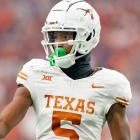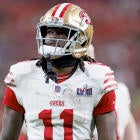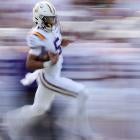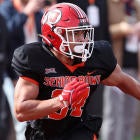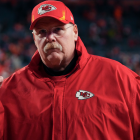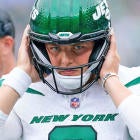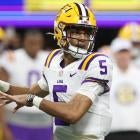Arguably the biggest story in the NFL through three weeks of the regular season is the play of two rookie quarterbacks that nobody expected to be starters when training camp broke.
Carson Wentz, the No. 2 overall pick in the draft, was expected to sit for a while behind Sam Bradford and Chase Daniel in Philadelphia, but an unexpected injury in Minnesota and the subsequent trade of Bradford to the Vikings thrust Wentz into Eagles' starting lineup -- where he has shined beyond reasonable expectations.
Similarly, Dak Prescott was drafted by the Cowboys with the intention that he'd sit and learn behind Tony Romo before taking over the top job a two or three years down the line. But when Romo suffered yet another back injury after his backup Kellen Moore had already broken his ankle, Prescott was elevated to the No. 1 role -- where he, too, has excelled.
With his team sitting at 3-0 and coming off a 34-3 drubbing of a Pittsburgh Steelers team that many consider Super Bowl contenders, Wentz has gotten quite a bit more hype than Prescott during the early part of the regular season, but a look at the tape and their numbers reveals that the two passers have actually been more equal than one might initially think.
Let's dig in.
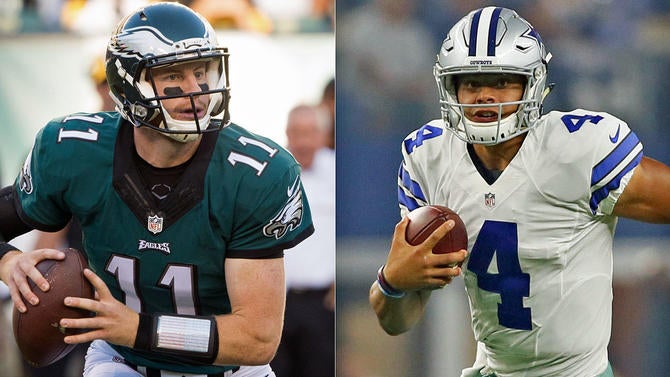
Team Offense
Take a look at the following chart:
| STATISTIC | PHI (RANK) | DAL (RANK) |
| PPG | 30.7 (2) | 25.7 (11) |
| PTS/DRIVE | 2.68 (2) | 2.66 (3) |
| SCORE % | 50.0% (4) | 51.7% (2) |
| FIELD POS | 34.9 (1) | 28.9 (13) |
| DVOA | 18.8% (5) | 20.4% (4) |
Through three weeks, the Eagles have averaged a full five points more per game than the Cowboys. A slightly deeper look, however, reveals the two offenses have actually been equally effective. Why? Well, the Eagles have had 34 meaningful drives this season, per Pro-Football-Reference, while the Cowboys have only had 29. The latter figure is the lowest total in the league.
On a per-drive basis, the Eagles are scoring 2.68 points, while the Cowboys are right behind them at 2.66 points per drive. The difference is practically negligible. The Cowboys have actually finished a greater percentage of their drives with a score despite the fact that the Eagles haven't turned the ball over yet while the Cowboys have lost two fumbles (one of two Ezekiel Elliott fumbles was recovered by Washington in Week 2; and Terrance Williams fumbled at the end of a 47-yard catch and run in Week 3).
Not only that, but Dallas has reached those figures despite starting its average drive 6 yards farther away from the end zone than Philadelphia, which so far has the best average starting field position in the league thanks to a defense that has been utterly dominant in every way imaginable. Six yards of field position may not sound like a whole lot, but it is. Last season, 6 yards separated the team with the best average starting field position (Kansas City) from the team that finished 29th in the same stat (Houston). In 2014, it was the difference between first (Miami) and 31st (Washington). It's massive.
Those factors are a large part of the reason why the Cowboys rank slightly ahead of the Eagles in Football Outsiders' Offensive DVOA (Defense-adjusted Value Over Average, which adjusts performance for down, distance, and opponent) through this early part of the season.
Establishing that the two offenses have been of similar quality is not what we're really here for, though. The idea is to determine how much responsibility Wentz and Prescott bear for the success of those offenses so far. We'll start with the numbers before we dig into the factors that have contributed to how well these two have played.
Note: We're looking only at the three regular season games played by Wentz and Prescott. College and preseason tape and numbers have been excluded.
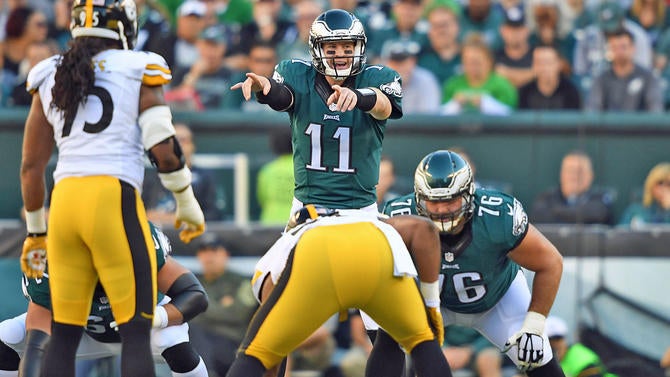
The Numbers
We'll begin with another chart here:
| STATISTIC | WENTZ | PRESCOTT |
| COMP | 67 | 66 |
| ATT | 102 | 99 |
| COMP % | 65.7% | 66.7% |
| YDS | 769 | 767 |
| YPA | 7.54 | 7.75 |
| TD | 5 | 1 |
| INT | 0 | 0 |
| RTG | 103.8 | 93.3 |
| QBR | 66.0 | 82.5 |
| aDOT | 7.7 | 9.2 |
As you can see, Wentz and Prescott have thrown almost the exact same number of passes for almost the exact same number of yards. They have completed almost the exact same percentage of those passes and neither of them has had a pass intercepted.
The main difference in their standard-issue stats is the five-to-one touchdown advantage for Wentz, which we'll come back to later on. That advantage, though, is what gives Wentz the edge in passer rating; while Prescott's work on the ground (seven carries for 54 yards and two touchdowns) and on third downs (23 of 30 for 253 yards and a touchdown) are likely what push him ahead in ESPN's Total QBR.
From a pure passing perspective, though, it's important to note a major difference in the way Wentz and Prescott have accumulated their statistics. Of Wentz's 102 passes, 20 of them have been thrown to receivers behind the line of scrimmage. That's nearly 20 percent of his total throws, and he's racked up 19 completions, 136 yards and one of his five touchdowns on tosses that were essentially uncontested.
Prescott, meanwhile, has thrown only nine passes behind the line of scrimmage, totaling eight completions for 55 yards.
Removing those throws from the equation for each quarterback gives you a slightly different look at their performance thus far:
| STATISTIC | WENTZ | PRESCOTT |
| COMP | 48 | 58 |
| ATT | 82 | 90 |
| COMP % | 58.5% | 64.4% |
| YDS | 633 | 712 |
| YPA | 7.72 | 7.91 |
| TD | 4 | 1 |
| INT | 0 | 0 |
| RTG | 99.3 | 92.5 |
Those throws, of course, actually happened -- they were attempted and (mostly) completed and the yards they accounted for really were accrued. Removing them simply gives us an idea of how much the scheme has helped each quarterback thus far.
Philadelphia has taken a screen-heavy approach and it has given Wentz the opportunity to take easy yards the defense can't really prevent. That they have players such as Darren Sproles and Jordan Matthews that do excellent work after the catch plays a role in that; and those players, in particular, have helped Wentz immensely.
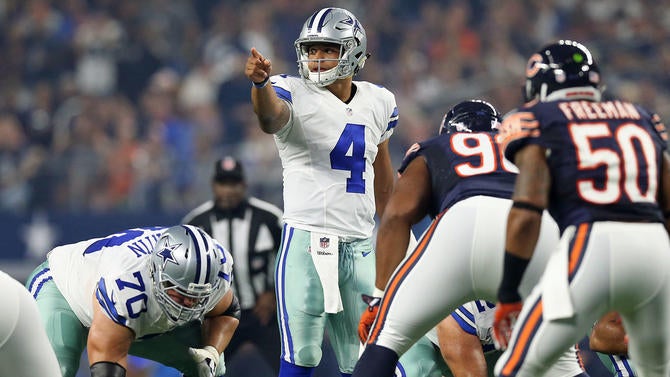
As such, Wentz has gotten a far greater percentage of his total yards via post-catch runs by his receivers. Per Pro Football Focus, only one quarterback (Matt Ryan) has accrued a lower percentage of his passing yards pre-catch than Wentz's 46.0 percent figure. That's far lower than the NFL average of 57.1 percent, while Prescott is above that average with a 58.6 percent figure.
The Cowboys have asked Prescott to work more often in the short-to-intermediate area beyond the line of scrimmage. Players like Cole Beasley and Jason Witten have been his primary targets as he's flashed only inconsistent chemistry with Dez Bryant.
A quick look at each player's passing grid highlights the slight differences in their teams' approaches through the early part of the season. (Remember, 20 of Wentz's "short" throws were intended for receivers behind the line of scrimmage, while the same is true of only nine of Prescott's throws.)

As you can see, there are no true areas of weakness for either player, with the exception of Prescott throwing deep (20-plus yards downfield). After going 0 for 6 on those passes in Week 1 against the Giants, though, he almost completely excised them from his game in Weeks 2 and 3, preferring instead to play to his strengths.
That's as good a place as any to transition ...
Strengths
Wentz has shown both the ability and the willingness to take the easy throws that the defense gives him. If that sounds like a pejorative, well, why don't you tell that to Tom Brady -- the NFL's preeminent "take what the defense gives you" master.
Wentz has done a good job identifying his first read before the snap, then throwing to him immediately if he flashes even remotely open. He's gotten the ball into the hands of his playmakers and let them go to work. This has been especially noticeable in the screen game and on quick hitch and curl routes.
Though he has under-thrown a couple, he's also shown really nice touch on several deep fade routes. Both of his touchdown passes during Philly's Week 1 win over the Browns came on fades -- one to each side of the field. He should have had another touchdown toss to Jordan Matthews on the same route in Week 2, but Matthews dropped it.
Wentz's best work, though, has come when his protection has broken down and he's used his legs to make something out of nothing. The single best skill either of these players has shown this season is Wentz's ability to escape from pressure and make throws from outside the pocket. On several occasions, he has broken containment scooted to the edge of the formation, then thrown the ball down the field for big plays. The most notable of those was a 73-yard catch-and-run to Darren Sproles against the Steelers in Week 3, but he also found Brent Celek with a throw against his body while moving to his left in Week 2 that was a thing of beauty.
While Wentz has looked to leave the pocket amid pressure, Prescott has instead stepped up within the pocket and kept scanning the field, only taking off as a last resort. His most impressive trait thus far is that he's hung in the pocket as long as possible, reading his progressions and coming back to second, third, or even fourth options and hitting them for chunk gains. He may have completed more passes to Beasley after first looking to Bryant or Witten in Week 3 than Wentz has completed to his third or fourth option all season.
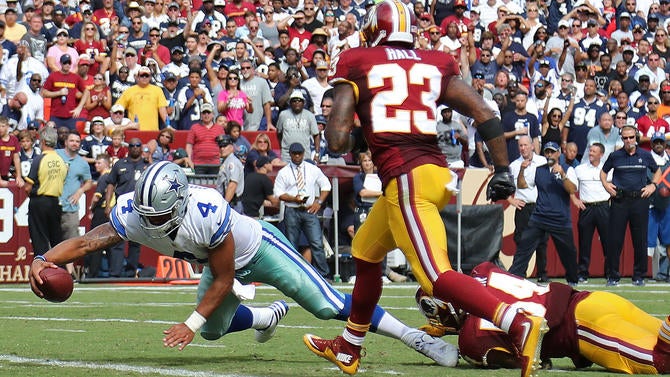
On the few occasions when he has taken off with the football, it's usually been up the middle after climbing in the pocket and looking for a receiver. Just one of his five scrambles has come when after he escaped the pocket to the outside. It helps that he typically gets excellent protection from the interior of his offensive line, but it's also a desirable trait for a quarterback to have.
Prescott has also proven himself to have excellent skill manipulating the ball in play-action, especially on bootlegs. Witten and Geoff Swaim have been open with no defender within 10 yards of them twice each after Prescott first faked a hand-off to Ezekiel Elliott and then rolled out of the pocket in the opposite direction. Some of Prescott's ability to sell the defense on the run is due to the strength of the actual running game, but a lot of it is that it really does look like he's handing Elliott the ball before he pops out on the other side of the formation.
Weaknesses
Wentz, when he hasn't gotten rid of the ball to his first read or taken off from the pocket if that player didn't flash open immediately, has been too statuesque in the pocket. He's rarely stepped up and into the pocket before delivering the ball (only two of his completions have come in this fashion), instead sitting back at the top of his drop and letting the rush surround him. He's made a few nice throws under duress, but too often he's had to throw off his back foot when the pressure gets to him. He luckily has not been under pressure much, but has only completed 10 of 20 passes in those situations, per PFF.
His touch on short throws, and his ball placement in general, has also left something to be desired. He's overthrown receivers on crossing routes a few times such that they had no chance at all to catch the pass, and he's misfired low and behind his receivers on several out-breaking routes, a couple of which should probably have been picked. (Artie Burns would have had one last Sunday if he simply looked at the ball heading right at him.)
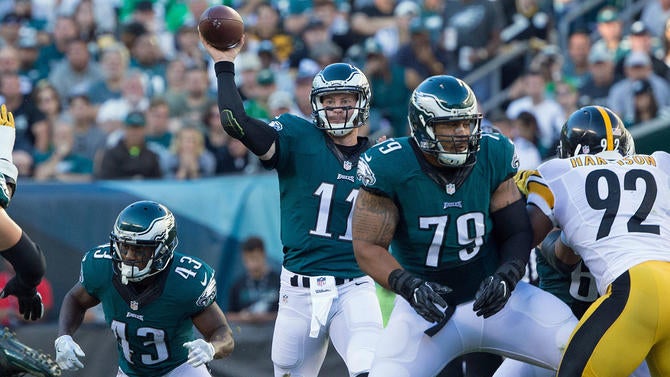
And while he's made a whole mess of plays when leaving the pocket, he needs to learn when to slide if he takes off down the field. He took two huge hits against the Bears that were just completely unnecessary. It's great to see a big, young QB take a hit, dust himself off, and get back up -- but we also don't want to have to see him do that too often.
While Prescott was probably considered the more mobile QB entering the draft and thus likely the better thrower on the run, he has actually yet to complete a pass after escaping the pocket to the outside. He's done so only a few times, but when he has, all of his throws have either sailed over his receiver's head or gone straight into the ground.
Prescott has not been great with his ball placement on throws down the field (even his lone completion on a throw 20-plus yards down the field would have been a touchdown had it been a better throw), and especially, on back shoulder throws. He simply has no chemistry with Bryant on what is his and Romo's best play. The Cowboys tried to force Bryant a few back-shoulders in the red zone, and none of them have come close to working.
Prescott has also shown the occasional tendency to throw the ball behind his man on crossing patterns, a dangerous habit. Jason Witten lost a ball in the sun because Prescott threw it behind him on the Cowboys' attempted last-ditch comeback drive in the season-opener, and Prescott missed Bryant with a crosser in the same manner against Washington in Week 2.
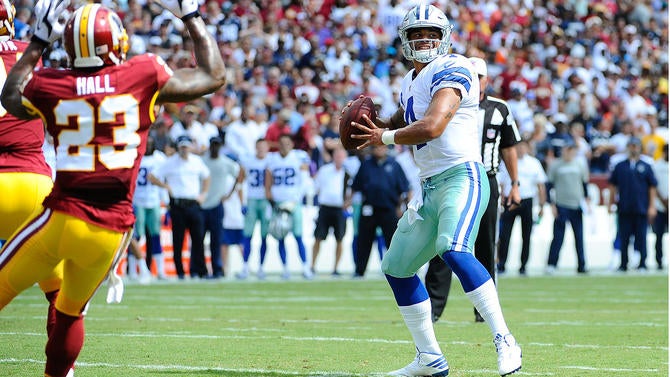
Overall Impressions
While both players have been extremely impressive so far, Wentz has been slightly more so. The five-to-one touchdown advantage oversells how much better he's been by a decent amount. Prescott had a touchdown pass to Dez Bryant overturned on review and has twice seen his receiver catch a pass and get tackled at the 1-yard line before the Cowboys later scored on a rushing touchdown.
Wentz threw a 2-yard touchdown that came immediately after a Jay Cutler interception was nearly returned for a touchdown -- but his ability to extend the play with his legs and make plays outside the pocket has shown through in all three games, he has shown better touch on throws down the field, and his desire and willingness to deliver the ball soon after the snap meshes well with the way the NFL is trending.
None of that is to discount the work done by Prescott, though. His game against the Bears last Sunday was probably the best individual game either player has had so far. His overall work in the short and intermediate areas of the field has been superior to Wentz's and he's also been excellent when teams have sent extra rushers after him. His preference for climbing in the pocket and keeping his eyes downfield is arguably a more desirable trait than Wentz's freelancing outside the pocket, since he is less likely to take big hits and he will have cleaner running lanes if and when he decides to take off. It would be entirely reasonable to conclude that he's actually been the better player thus far had he not forced several downfield and back shoulder throws that simply had no chance.
Either way, both the Eagles and Cowboys should be thrilled with what they've seen from their rookie passers so far. If they keep this up for the next few weeks, it starts becoming reasonable to not just hope, but expect that they can be starter-quality quarterbacks in this league.














